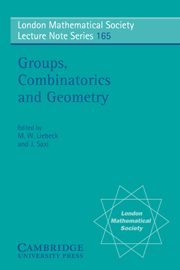Book contents
- Frontmatter
- Contents
- Authors' Addresses
- Introduction
- Part 1 Sporadic groups
- 1 Uniqueness of sporadic groups
- 2 The study of J4 via the theory of uniqueness systems
- 3 Y555 and all that
- 4 Hyperbolic reflections for the Bimonster and 3Fi24
- 5 A geometric characterization of the Monster
- 6 Constructing the Monster
- Part 2 Moonshine
- Part 3 Local and geometric methods in group theory
- Part 4 Geometries and related groups
- Part 5 Finite and algebraic groups of Lie type
- Part 6 Finite permutation groups
- Part 7 Further aspects of simple groups
- Part 8 Related topics
1 - Uniqueness of sporadic groups
Published online by Cambridge University Press: 07 September 2010
- Frontmatter
- Contents
- Authors' Addresses
- Introduction
- Part 1 Sporadic groups
- 1 Uniqueness of sporadic groups
- 2 The study of J4 via the theory of uniqueness systems
- 3 Y555 and all that
- 4 Hyperbolic reflections for the Bimonster and 3Fi24
- 5 A geometric characterization of the Monster
- 6 Constructing the Monster
- Part 2 Moonshine
- Part 3 Local and geometric methods in group theory
- Part 4 Geometries and related groups
- Part 5 Finite and algebraic groups of Lie type
- Part 6 Finite permutation groups
- Part 7 Further aspects of simple groups
- Part 8 Related topics
Summary
Initial work on the sporadic finite simple groups falls into one or more of the following categories:
Discovery
Structure
Existence
Uniqueness
More precisely let H be some group theoretic hypothesis. A group theorist begins to investigate groups G satisfying H and generates information about the structure of such groups. Typical examples of structural information include the group order, the isomorphism type of normalizers of subgroups of prime order, and perhaps eventually the character table of G. When a sufficiently large body of self-consistent structural information has been generated, the group is said to be discovered. This is roughly the point where the group theoretic community first becomes convinced that the group exists.
The group actually exists when there is a proof that there is at least one group satisfying hypothesis H, while the group is unique when there is a proof that, up to isomorphism, there is at most one group satisfying H. More detailed information about the group structure usually comes later and might include the calculation of the automorphism group and Schur multiplier of G, an enumeration of the maximal subgroups of G, and the generation of the modular character tables for G.
As part of the ongoing effort to produce a complete, unified, and accessible proof of the Classification Theorem, Aschbacher has begun to try to write down in one place a complete and fairly self-contained proof that the 26 sporadic groups exist and are unique. The plan is to generate at the same time the basic structural information about each sporadic group necessary for the Classification.
- Type
- Chapter
- Information
- Groups, Combinatorics and Geometry , pp. 1 - 11Publisher: Cambridge University PressPrint publication year: 1992



